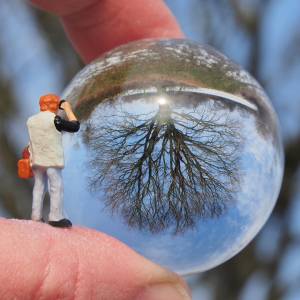A new begin
I was at the ONE TREE for the first time in the new year. We have had some singel snowflakes in the night and I hoped for some snow at the tree.
I was happy, when I spotted some white sparkles at the fallen leaves, but when I had a closer look I noticed that it wasn't any snow but organism, which were busy decomposting the leaves.
I found this interesting article. (Thanks google for translation):
Every year, a hundred-year-old beech leaves a good half a million leaves. This results in a foliage layer of five to ten centimeters in height under their crown. Every year on average, about five tons of leaves and wood remains fall from the trees in one hectare of mixed forest. That's a weight of three to four mid-range cars. Nevertheless, there are no mountains of foliage piling up in our forests, the leaves and wood remains disappearing over the year. They are decomposed on the ground, that is, transformed back into their individual constituents. The same thing happens with the underground biomass, that is, dead roots. All of this serves as a food source for various soil organisms.
How quickly the leaves are decomposed depends on the climatic conditions. In cooler regions like the Alps, for example, decomposition is slower and higher humus deposits can form here. In contrast, the decomposition in the tropics is quite fast. In our latitudes, the conditions are quite favorable, so that the organic material is decomposed again within a few years. On the other hand, the tree species is crucial. The organic material of hardwood stands tends to decompose faster than that of coniferous populations. In addition, of course, the soil physical and soil chemical properties play a role.
The decomposition does not start until the leaves are on the ground, but already on the tree. Here are the valuable ingredients for the tree such as chlorophyll taken from the leaves and integrated into the material cycle of the tree. This is visible in the autumnal coloring of the leaves. At the same time, fungi and bacteria are on the leaves and begin to decompose on the tree. Once the leaves have reached the ground, the soil organisms begin their work - only beetles, woodlice, worms, snails, mites and millipedes are said to break down the leaves mechanically. Thereafter, the remnants, the hard-to-digest ingredients such as lignin, from fungi and bacteria off and rebuilt. The faeces of the animals are converted into new organic substances, the humic substances that form the actual humus. The leaves, needles, branches and roots have become organic substances, the humus remains.
The activity of soil organisms is influenced by temperature, humidity, air and acidity. The humus they form is rich in minerals. These minerals are very important for tree nutrition. At the same time, the humus has a positive effect on physical and chemical soil properties, especially as a water and nutrient storage. (forstcast.net)
- 2
- 0
- Olympus E-M5
- 1/100
- f/6.0
- 43mm
- 800

Comments
Sign in or get an account to comment.


